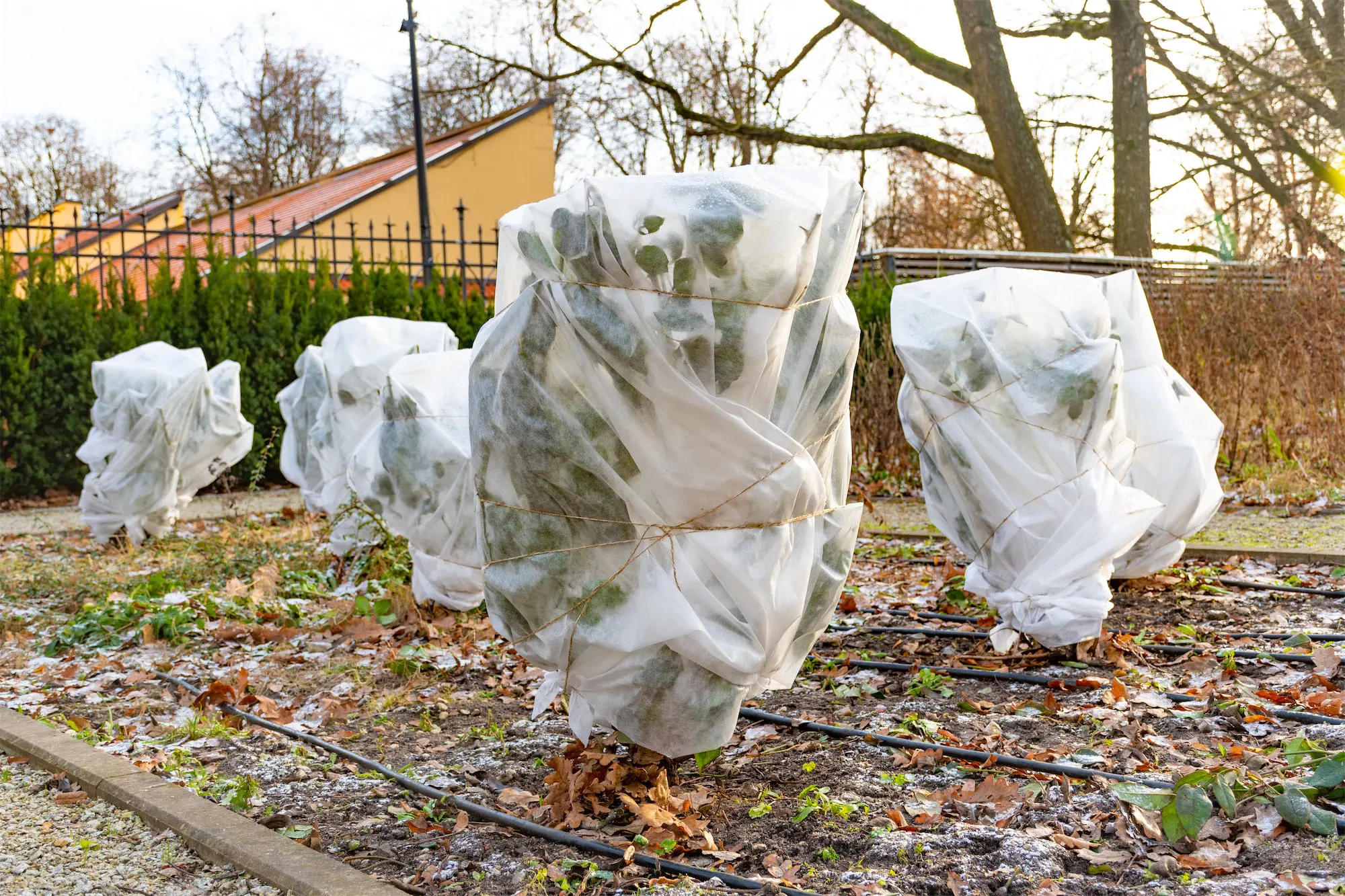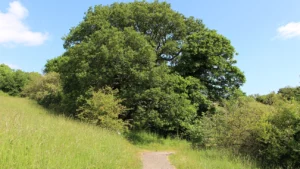How to Protect Trees From a Freeze: Essential Tree Care Tips from Treeier
How to Protect Trees From a Freeze involves essential tree care practices like applying mulch and using tree wraps for frost protection. These strategies help in temperature control and freeze damage prevention, ensuring the overall health of your trees during the dormant season.
Understanding Freeze Damage and Tree Vulnerability
Winter can be tough on trees. It’s important to know about freeze damage and tree vulnerability to help them survive. Cold weather can cause problems like frostbite and root issues. Taking care of your trees during this time not only helps them but also keeps your yard healthy and looking good.
Frost vs. Freeze: Key Differences for Tree Care
Frost happens when temperatures drop below 32°F (0°C) at night. It makes moisture in the air freeze on things like leaves and branches. This can cause frost damage, leading to browning or wilting leaves.
A freeze is when the temperature stays below freezing for a longer time, affecting the entire tree, including its roots. Here’s what can happen:
- Leaf Damage: Leaves might turn brown or mushy.
- Root Heaving: Freezing soil pushes roots up, causing damage.
- Bark Cracking: Quick temperature changes can make bark split.
Knowing these differences helps you with frost protection for trees and prepares them for freeze-thaw cycles that can hurt their growth.
Hardiness Zones and Their Impact on Tree Survival
The USDA Plant Hardiness Zone Map shows what types of plants grow well in certain climates based on the average coldest winter temperatures. Knowing your hardiness zone helps you choose the right tree species that can handle cold weather.
Here are some points about hardiness zones:
- Cold-Hardy Trees: Trees from colder areas usually deal better with low temperatures.
- Microclimates: Local spots, like areas near buildings, can affect how trees survive winter.
- Planting Timing: Planting at the right time helps trees get settled before harsh winter hits.
By matching tree choices with appropriate planting zones, you lower risks from extreme cold weather impacts on trees.
Identifying Trees Most Susceptible to Cold Weather
Some trees are more sensitive to cold weather than others:
- Thin-Barked Trees: Trees like birch or cherry don’t have much insulation against freezing.
- Young Trees: Newly planted trees haven’t established strong roots; they need extra care in winter.
- Non-Native Varieties: Tropical species struggle more with colder temperatures compared to native ones.
To keep your landscape safe:
| Type of Tree | Characteristics |
|---|---|
| Evergreen | Keep their leaves all year |
| Deciduous | Lose their leaves every year |
| Cold-Hardy Varieties | Grow well in low temps |
Choosing cold-hardy tree species for your area will help them resist severe winter challenges and thrive come springtime.
Essential Freeze Protection Techniques for Trees
Keeping trees safe during freezing weather is super important for their health. Using the right freeze protection techniques can help avoid frost damage. Here are some key strategies to protect your trees in winter:
Covering Methods: Tree Wraps, Burlap, and Horticultural Fleece
Protective coverings are a great way to keep trees warm in winter. Here are some good options:
- Tree Wraps: These wraps help trap heat around the trunk and protect against sunscald.
- Burlap Tree Cover: This fabric lets air flow while shielding the tree from cold winds. It’s especially helpful for young trees.
- Frost Cloth for Trees: Lightweight fleece can be laid over branches to keep them warm without blocking growth.
These covering methods not only offer immediate freeze protection but also help trees get stronger against future cold spells.
Proper Watering Practices Before and During Freezing Temperatures
Watering properly is key to avoiding freeze damage. Wet soil keeps roots insulated better than dry soil. Here’s how to do it:
- Water deeply before the cold hits.
- Keep an eye on moisture levels all winter. If there’s not much rain or snow, consider watering when it’s warm enough.
This helps maintain healthy roots even when it’s really cold.
Mulching Strategies for Root Insulation and Moisture Retention
Mulch is very helpful in protecting tree roots during winter. It provides insulation and keeps moisture in the soil.
For effective mulching:
- Use organic materials like wood chips, straw, or shredded leaves.
- Apply a layer 2–4 inches thick around each tree’s base but leave space around the trunk to prevent rot.
This not only protects roots but also improves soil quality as it breaks down over time.
Weed and Turf Removal to Improve Soil Heat Absorption
Removing weeds and grass around your trees helps them soak up more sunlight and warmth. Weeds take away nutrients and water that your trees need during tough weather.
Here’s what you can do:
- Clear weeds at least 2 feet away from the trunk.
- If weeds keep coming back, think about using landscape fabric under mulch layers.
By giving your trees better access to heat, you help them grow healthier even in rough conditions.
Recognizing and Addressing Cold Damage in Trees
Leaf Symptoms: Winter Burn and Dieback
Cold damage shows up in trees, especially on their leaves. Winter burn happens when strong winds and freezing air suck moisture from leaves. This can make leaves turn brown or get crispy edges. Trees that have already leafed out before a cold snap are most affected.
Dieback is another sign to watch for. It means parts of the tree, like twigs or branches, slowly die because of harsh cold. So, keep an eye on your trees during winter. Look for these signs as they can mean your tree is stressed. For good cold damage recovery, check soil moisture and take care of your trees in winter.
Bark Issues: Frost Cracks and Sunscald
Bark plays an important role in keeping trees healthy, but it can be damaged by freezing weather. Frost cracks form when quick changes in temperature stress the bark. This can cause cracks or splits that hurt the tree and let pests in.
Another issue is sunscald, which happens when warm sunlight hits frozen bark too quickly. This can lead to peeling or cracking of the bark too. To help prevent these problems, wrap trunks with protective materials during cold winters for better frost protection for trees.
Root and Limb Damage: Frost Heaving and Breakage
Roots are super important for soaking up nutrients, but they can face challenges in the cold too. Frost heaving occurs when the soil freezes and thaws repeatedly over winter, pushing roots closer to the surface instead of keeping them deep underground.
Also, limbs can break under heavy snow or ice due to low temperatures. This kind of damage can seriously hurt overall tree health during winter if not fixed quickly:
- Keep mulch around root zones.
- Water deeply before freeze events.
- Gently remove excess snow from branches after storms.
By taking these steps against frost heaving and limb breakage, you help your trees withstand tough winter weather.
Post-Freeze Tree Assessment Techniques
After a freeze event, checking on your trees is key to knowing how they’re doing:
- Inspect Leaves: Look for browning or dieback.
- Check Bark: Find any cracks or sunscald needing attention.
- Evaluate Roots: Carefully dig around roots; see if they’ve been pushed up by frost heaving.
- Examine Limbs: Check for broken branches; prune damaged parts but avoid cutting too much which could hinder recovery.
Regular checks after a freeze help keep your trees healthy while good maintenance practices throughout the year promote their longevity, even through harsh winters.
Recovery and Repair After Freezing Events
Winter can really harm trees. Cold damage can hurt their health. Knowing how to help your trees recover after freezing events is key to keeping them strong. Here are some simple steps you can take:
- Watch for Damage: Look for broken branches or bark splits.
- Prune Wisely: Trim away dead or badly damaged parts. This helps stop diseases and encourages new growth.
- Keep Some Branches: Don’t cut too much; healthy branches need to stay for tree health.
- Time it Right: Prune in late winter or early spring when it’s warmer.
By following these tips, you help ensure your trees bounce back after the cold.
Proper Pruning Practices for Damaged Trees
Pruning in winter might seem odd, but it’s really important for damaged trees. Here are some smart ways to do it:
- Check the Damage: Look closely at what’s hurt.
- Cut Dead Parts: Remove dead branches so your tree can heal better.
- Leave Healthy Ones: Always keep healthy branches intact.
- Choose the Right Time: Wait until it warms up a bit before big cuts.
Taking these steps can lead to better tree maintenance and a stronger recovery.
Sunscald Repair and Prevention Methods
Sunscald can be tricky. It happens when a tree’s bark faces sudden heat and cold changes. To help prevent this:
- Use Whitewash: Mix white latex paint with water and coat the trunk on sunny winter days.
- Wrap Trees: Cover young trunks with burlap or special wraps from fall until spring.
- Watch Weather Changes: Keep an eye on fast temperature swings.
Using these methods helps reduce frost damage and keeps the bark healthy during colder months.
Soil Care to Support Root Recovery
Healthy soil is super important after cold injuries. Here are some good soil care ideas:
- Moisture Retention:
- Water your trees deeply but not too often during dry times.
- Put mulch around the base; it helps keep moisture in and regulates temperature.
- Aeration:
- Use a garden fork to loosen compacted soil. This lets air get to roots which helps them heal.
- Organic Matter Addition:
- Add compost to enrich the top layer of soil. This gives nutrients and improves drainage.
These tips will support root systems as they recover from cold damage, making your trees healthier during winter.
When to Seek Professional Arborist Assistance
Sometimes, calling in an expert is a good idea:
- If you’re unsure about how bad the damage is,
- When big pruning is needed that’s too much for home care,
- For special treatments against diseases caused by freeze injuries,
Local arborists offer valuable help tailored to community gardening needs. They provide advice on landscaping services that protect local plants after freezing events. Getting professional help ensures right actions are taken quickly without hurting plant health further down the road.
Recovery and Repair After Freezing Events
Proper Pruning Practices for Damaged Trees
After a freeze, check your trees for damage. Proper pruning is key to helping them recover. Here are some easy steps to follow:
- Timing: Wait until late winter or early spring to prune. This helps you see all the damage and reduces stress on the tree.
- Remove Dead Wood: Cut away broken branches or dead limbs. This prevents growth problems and keeps pests away.
- Avoid Over-Pruning: Only take off what’s needed. Too much pruning can make trees weaker during post-freeze recovery.
- Clean Cuts: Use sharp tools for clean cuts. This helps prevent diseases.
Following these steps will help keep your trees healthy as they recover from frost damage.
Sunscald Repair and Prevention Methods
Sunscald happens when temperatures change too fast. The bark can thaw during sunny days but refreeze at night. To fix and prevent sunscald, try these ideas:
- Whitewash Application: Use a mix of white latex paint and water on exposed bark. This reflects sunlight and keeps temperature changes in check.
- Wraps for Protection: Put tree wraps made of breathable materials around young trunks in winter. This shields them from strong sun.
- Healthy Canopy Maintenance: Make sure your tree has enough leaves before winter. This natural cover helps protect against sunscald.
These methods support tree health during winter and stop future frost-related problems.
Soil Care to Support Root Recovery
Healthy soil is super important for root recovery after freezing events. Focus on these points:
- Moisture Retention: Keep the soil moist but not too wet by watering deeply once a week if there’s no snow cover.
- Organic Mulch Layering: Put down a 2-to-4-inch layer of organic mulch around your trees’ bases. It keeps roots warm, holds moisture, and stops weeds from stealing nutrients.
- Aeration Techniques: If the soil is compacted from freeze-thaw cycles, aerate it gently with garden forks or special tools, being careful not to hurt the roots.
Caring for soil helps protect roots, which is vital for plant health after cold weather stressors.
When to Seek Professional Arborist Assistance
Sometimes doing it yourself isn’t enough! Knowing when to call local experts can save time and effort:
- If big branches are damaged beyond simple repairs,
| Signs You Need Help | Description |
|---|---|
| Large Broken Limbs | These need heavy tools for safe removal |
| Extensive Bark Damage | May require professional care |
| Tree Leaning Unnaturally | Could mean the tree is unstable |
Professional arborists have the skills to assess situations accurately and provide proper solutions through landscaping services. This ensures long-term health benefits in community gardening efforts that aim to keep local greenery thriving.
Recovery and Repair After Freezing Events
After a freeze, trees can get hurt in different ways. It’s really important to help them bounce back. This support can keep tree health during winter and reduce cold damage recovery issues. Here’s how you can help:
- Check for Damage: Look for broken branches or bark.
- Give Water: Make sure trees get enough water during dry spells.
- Fertilize if Needed: A little fertilizer can help new growth.
Doing these things can promote post-freeze recovery and improve tree health.
Proper Pruning Practices for Damaged Trees
Pruning in winter is tricky. You shouldn’t prune too soon after a freeze, as this can hurt the tree more. Wait until late winter or early spring when it starts warming up. Follow these steps:
- Look for Dead Branches: Check which branches are broken or dead.
- Remove Danger: Cut any limbs that might fall or are too damaged.
- Make Clean Cuts: Use sharp tools to cut at an angle. This helps prevent water from sitting and causing rot.
- Don’t Overdo It: Only take off what’s needed to keep healthy trees.
By using these proper pruning practices, you can help with cold damage recovery and keep your trees looking great.
Sunscald Repair and Prevention Methods
Sunscald happens when warm sun hits frozen bark, causing cracks. This can lead to bigger problems if not fixed quickly. To help repair and prevent sunscald:
- Use Whitewash: Mix some water-based paint with water and apply it to protect the bark.
- Wrap Young Trunks: Cover the trunks of young trees with protective wraps in harsh weather.
- Water Regularly: Keep trees hydrated before winter; this helps them stay strong.
These methods will improve your tree’s resistance against frost damage.
Soil Care to Support Root Recovery
Healthy soil is key to supporting roots after a freeze. Here’s how you can care for it:
- Mulching: Put organic mulch around the tree base. It keeps moisture in and warms up the roots.
- Deep Watering: Water deeply before it freezes to ensure roots have enough moisture during colder times.
- Aerate the Soil: If your soil is hard, aerating it helps roots get air and nutrients better.
Taking care of the soil boosts root protection and aids in overall post-freeze recovery.
When to Seek Professional Arborist Assistance
If you’re not sure what your tree needs after a freeze, call local tree services for help:
- They can give expert advice on cold damage.
- They offer solutions based on what type of trees you have.
- They help create long-term care plans for your trees.
Reaching out for professional assistance ensures your trees get the right care they need during their recovery.
FAQs on Protecting Trees from Freezing
1. How can I ensure my tropical trees survive winter?
Tropical trees often struggle in cold weather. Use tree wraps and mulch to insulate them. Choose sheltered areas for planting and cover them when frost is expected.
2. What are effective winterizing techniques for fruit trees?
Fruit trees need extra care during winter. Mulch around the base to retain moisture. Water deeply before a freeze and check for pests frequently.
3. What should I do about soil temperature management for my trees?
Maintaining proper soil temperature is essential. Use mulch to regulate soil temperature. This helps protect roots from freezing and promotes healthy growth.
4. How can I help my trees get enough nutrients in winter?
Feed your trees before winter hits. Use organic fertilizers to boost their nutrient levels. This strengthens them against cold stress.
5. Are there non-toxic ways to control pests on trees during winter?
Yes, use natural repellents like neem oil or insecticidal soap. These methods protect trees without harmful chemicals, promoting healthier environments.
6. How does community gardening help with tree survival?
Community gardening fosters collaboration among neighbors. Shared knowledge enhances tree care practices, boosting survival rates during harsh weather.
Additional Tips for Winter Tree Care
- Cold Weather Tree Care: Shield young and sensitive trees from extreme cold with covers.
- Tree Maintenance: Regular checks can prevent frost damage early.
- Native Trees: Opt for native species that better withstand local climate conditions.
- Invasive Species Prevention: Keep an eye on invasive plants around your trees; they can compete for resources.
- Environmental Benefits of Trees: Healthy trees improve air quality, provide shade, and support wildlife.
- Ecosystem Services: Well-maintained trees enhance local ecosystems by preventing erosion and promoting biodiversity.
- Montgomery County Resources: Utilize local gardening resources for tailored advice on protecting your trees from freezes.






